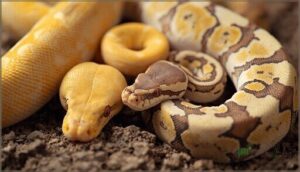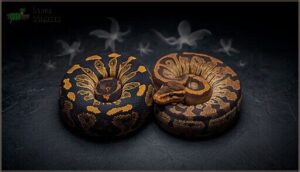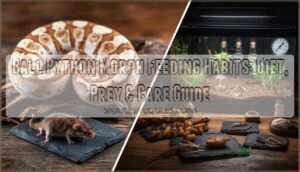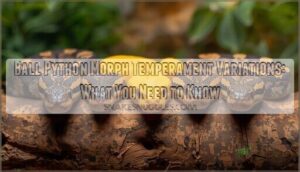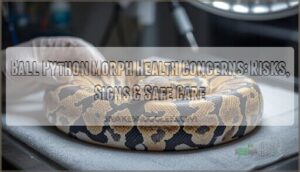This site is supported by our readers. We may earn a commission, at no cost to you, if you purchase through links.

When you pick up a ball python labeled “het albino,” you’re holding a snake that looks completely normal but carries a hidden genetic secret. That secret becomes real when paired with the right mate, suddenly producing vibrant albino babies that look nothing like their parents.
This is the difference between visual and het traits in ball python genetics—one you can see, one you can’t, but both reshape what’s possible in your breeding plans.
Understanding this distinction gives you the power to predict which snakes will produce the morphs you want, avoid costly breeding mistakes, and recognize the true value in animals that might look ordinary at first glance.
Table Of Contents
Key Takeaways
- Visual ball pythons show their genetic traits in color or pattern, while hets look normal but carry hidden genes for future morphs.
- Recessive genes need two copies for visible traits, so breeding hets together gives you a mix of visuals, hets, and normals according to predictable ratios.
- Visual morphs usually cost much more than hets, but hets offer smart investment potential for breeders aiming to produce rare offspring.
- Health risks are higher in visual morphs due to genetic mutations, while het carriers tend to have fewer problems and make for safer breeding choices.
Key Genetic Terms in Ball Pythons
Understanding ball python genetics starts with learning the language breeders use every day. These terms aren’t just jargon—they’re the tools you’ll need to predict what your snakes will produce and make smart breeding decisions.
Let’s break down the essential concepts that separate a visual morph from a het and explain how different genes actually work.
Visual Vs. Het Definitions
Understanding visual and het ball pythons starts with allele expression. A visual shows the trait you can see—whether it’s striking albino coloring or bold patterns. This happens when genes line up just right. A het carrier looks normal but holds one copy of a recessive gene, giving it serious breeding potential even without visible trait observability.
- Visual ball pythons display physical traits from two copies of recessive genes or one copy of dominant genes
- Het carriers appear normal but pass hidden recessive genes to offspring
- Visual identification requires observable color or pattern changes in the snake
- Hets enable breeding potential by producing visual morphs when paired correctly
- One copy creates a carrier, two copies create the visual expression you’re after
Recessive, Dominant, and Co-dominant Genes
These three gene types shape trait inheritance and morph development in ball pythons. Recessive genes need two copies for visual expression—think Albino or Piebald morphs. Dominant genes show with just one copy, like Spider or Pinstripe. Co-dominant genes create a spectrum: one copy gives you Mojave, two copies produce Super Mojave.
Understanding dominant gene expression helps predict visual traits in offspring. Each inheritance pattern directly affects breeding outcomes and genetic variation.
Morphs and Genetic Mutations
Morphs result from genetic mutations affecting pigmentation and pattern genes—allele influence that creates everything from albinos to designer morphs. Mutation origins trace back to wild-caught African snakes in the 1990s.
Visual identification becomes straightforward once you understand incomplete dominance, where one gene copy alters appearance but two copies intensify it dramatically.
These mutations form the foundation of snake morph breeding today. Genes, inherited in pairs, determine traits.
Visual Morphs: How Traits Are Expressed
Visual morphs are the showstoppers of ball python breeding—they’re the snakes where you can actually see the genetic magic at work. When a morph is visual, it means the trait shows up in the snake’s appearance through color changes, pattern shifts, or both.
Let’s break down what makes a morph visual, look at some popular examples, and learn how to spot these traits yourself.
What Makes a Morph Visual
A visual morph appears when genetic mutations show up in your ball python’s color or pattern—you can see them without any testing.
These visual traits happen through genetic expression in three main ways: recessive genes need two copies to display the phenotype, dominant genes show with just one, and co-dominant genes create intermediate effects.
The visible phenotype reveals the hidden genotype through gene interaction and morph classification.
Common Visual Recessive Examples
You’ll see recessive genes shine in these five classic Visual Ball Python morphs:
- Albino variations strip away melanin, leaving yellow and white snakes with red eyes
- Piebald patterns create stunning white patches across the body
- Axanthic lines remove yellow pigment for grayscale beauty
- Clown markings display high-contrast headstamps
- Hypo colors reduce black for lighter, cleaner tones
Each requires two copies of the recessive gene—one from each het parent—to appear visually.
Identifying Visual Traits in Ball Pythons
You can spot visual traits by checking color intensity, pattern shifts, and eye color. Albino morphs show bright yellows with red eyes, while Piebald creates bold white patches. Look at belly patterns too—some visual morphs leave distinct ventral marks.
When multiple genes combine, visual dominance means certain morphs mask others. Unlike het carriers, these traits shine without genetic testing needed.
Het Ball Pythons: Hidden Genetics
Not every ball python shows off its genetic potential right away. Het snakes carry hidden recessive genes that don’t change their appearance but can produce stunning visual offspring when bred correctly.
Understanding how these hidden genetics work gives you the power to plan breedings that reveal those traits in the coming years.
Definition and Role of Hets
Think of a het ball python as a hidden treasure chest—it looks normal but carries valuable recessive genes inside. Here’s what makes hets so important:
A het ball python is a hidden treasure, appearing normal but secretly carrying valuable recessive genes for future morphs
- Heterozygous carriers possess one copy of a recessive trait but don’t show it visually
- Gene carriers pass hidden morphs to offspring when paired strategically
- Recessive traits need two copies to express, making hets essential breeding tools
- Morph expression relies on combining these carriers to reveal new patterns
Breeding Outcomes With Het Snakes
When you breed two het ball pythons together, expect 25% visual offspring, 50% het carriers, and 25% normals—that’s your classic Punnett square at work. Clutch variance factors mean actual results may differ from predicted het offspring ratios, but these percentages hold over multiple breeding seasons.
Visual confirmation methods prove the recessive gene’s presence, while economic breeding balance makes het pairings cost-effective despite uncertainty.
Double Het and Multi-Gene Hets
Double hets carry two different recessive genes, giving you a 1 in 16 shot at producing a visual snake showing both traits. Breeding probabilities drop sharply with multi-gene hets, making genetic verification important before investing.
Market value stays lower until visual influence proves your genetic combinations actually work. Ethical disclosure matters—always tell buyers exactly what het status you’re selling.
Inheritance Patterns and Predicting Offspring
Understanding how traits pass from parent to offspring is the key to predicting breeding outcomes. Once you know whether a gene is recessive, dominant, or co-dominant, you can map out the likely results before pairing your snakes.
Let’s break down the inheritance patterns that determine whether you’ll get visuals, hets, or normals in your clutch.
Recessive Gene Inheritance Explained
Recessive gene inheritance follows a simple rule: your ball python needs two copies of the gene—one from each parent—to show visual traits. Understanding inheritance patterns makes trait prediction and breeding ethics straightforward.
Here’s how it works:
- Two hets together produce about 25% visual offspring
- Visual paired with het yields 50% visual babies
- Visual bred to visual guarantees 100% visual results
- Double hets carry two different recessive genes for exciting breeding possibilities
Using Punnett Squares for Ball Pythons
You can map out your ball python genetics using Punnett Squares—simple grids that predict offspring traits by charting allele combinations from both parents. For recessive genes like albino, a 2×2 grid shows exactly what you’ll get: crossing two hets produces 25% visual, 50% het, and 25% normal babies.
| Parent 1 Alleles | Parent 2 Alleles | Offspring Outcome |
|---|---|---|
| Het x Het (Albino) | a, A | 25% visual, 50% het, 25% normal |
| Visual x Het | a, a + a, A | 50% visual, 50% het |
This genotype prediction tool makes breeding probabilities crystal clear, supporting ethical breeding decisions in ball python genetics whether you’re working with dominant, codominant, or double recessives.
Probabilities in Visual Vs. Het Pairings
Once you’ve laid out your Punnett Squares, you’ll see exactly how Visual offspring rates and Het offspring chance shift depending on your pairing. Visual x het gives you a 50-50 split between visual and heterozygous babies, with zero non-carrier probability.
Het x het follows classic Mendelian genetics: 25% visual, 50% het, 25% normal—Mendelian Ratios that balance genetic diversity while predicting offspring with considerable accuracy.
Breeding Strategies and Ethical Considerations
Understanding genetics is only half the equation—knowing how to apply that knowledge separates casual keepers from successful breeders. Your breeding decisions should balance your goals, budget, and responsibility to the animals you’re working with.
Let’s look at how to plan effective pairings and understand what different snakes are actually worth in today’s market.
Planning Pairings for Desired Traits
When planning pairings, you’ll want to start with at least one visual parent—this ensures you’ll see desired traits in your offspring right away rather than waiting multiple generations. Recessive pairing strategies work well with het foundation females, while dominant introduction adds variety. Stepwise breeding lets you build complexity gradually.
Always keep ethical considerations in mind: Ball Python genetics should balance visual appeal with animal health and genetic planning.
Market Value: Visuals Vs. Hets
Beyond breeding strategy, your wallet matters too. Visual morphs generally cost two to three times more than their het counterparts—think $500 for a visual versus $200 for a possible het carrying the same gene.
Rarity drives pricing: emerging visual traits in ball pythons can exceed $5,000, while common visuals drop below $300.
Hets offer smart investment potential, delivering breeding returns through future visual offspring without the steep upfront visual pricing that impacts your initial budget.
Frequently Asked Questions (FAQs)
Can visual and het ball pythons have health differences?
Yes, visual morphs often face higher morph health risks from recessive mutations, like vision problems or deformities. Het carrier status usually masks these genetic traits, leading to healthier breeding outcomes and fewer health issues—an ethical consideration for breeders.
How do shipping stressors affect visual and het morphs?
When shipping stress hits, both visual morphs and het ball python morphs are in the same boat—no major difference in morph susceptibility or recovery times.
Watch for post-shipping behavior, as genetic resilience doesn’t guarantee freedom from health issues.
Are visual morphs more sensitive to environmental changes?
Visual morphs in Ball Python Morphs often show greater morph sensitivity factors—like melanin loss and UV sensitivity—plus neurological morph care needs.
Environmental stress impact is higher for these traits, raising breeding ethical concerns and demanding careful husbandry choices.
What recordkeeping methods track het genetics reliably?
Picture a breeder’s desk, weaving together digital systems, paper methods, and DNA testing. Breeding logs, labeled sheds, and industry standards all track het and recessive genes, ensuring Ball Python genetics stay accurate and reliable across generations.
Conclusion
Like reading between the lines of a story, grasping ball python genetics—visual versus het lets you see beyond what’s obvious. Each snake is a chapter, holding clues about future outcomes.
When you understand how traits are passed down, your breeding choices become intentional, not accidental. The real magic isn’t just in bright colors—it’s in knowing what’s possible before it’s visible.
With this knowledge, you’re not just keeping snakes; you’re shaping the coming offspring’s genetic narrative.



